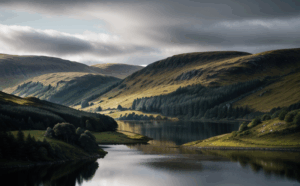Communities spanning the heart of Scotland, particularly across Perthshire and Stirlingshire, experienced an extraordinary day on Monday as two distinct seismic events, occurring within a mere 12-hour window, caused widespread rumbling. The more pronounced of these tremors, registering a magnitude of 3.7, sent noticeable vibrations through homes and businesses late in the afternoon, prompting widespread surprise and discussion among residents.
The epicentre of this afternoon’s stronger quake was precisely located at Pubil, an area situated near the stunning Loch Lyon, deep within the rugged landscape that defines parts of Perthshire. The ripple effect was extensive, with local councils confirming that the vibrations were distinctly felt across a broad swathe of the region. From the historic city of Perth itself to the scenic towns of Kinross and Cupar in Fife, the ground’s unexpected movement became an immediate talking point. Further afield, cities like Edinburgh and Glasgow, and even the distant coastal town of Stonehaven, received reports of the tremor, highlighting its considerable reach.
First-hand accounts from those who felt the earth shift underscored the unusual nature of the event. Many described an unsettling sensation of “some swaying” within their properties, an experience that caused momentary alarm. One resident vividly articulated their surprise, comparing the feeling to “an underground subway” passing directly beneath their home. These personal narratives collectively paint a picture of an unexpected and memorable incident, particularly in a country where such powerful tremors are far from a daily occurrence. A Preceding Jolt in the Morning
The Monday afternoon event wasn’t an isolated incident; it was preceded by an earlier, though slightly less potent, earthquake. This initial tremor, measuring 3.3 in magnitude, had already stirred residents awake at 7:25 AM. Its origin was also located in the Perthshire and Stirlingshire borderlands, reaching communities including Aberfeldy, known for its whisky and distilleries, Pitlochry, a popular tourist destination, and the tranquil villages of Kenmore, Rannoch, and Killin. For many, the early morning shake-up was an abrupt and startling start to the week.
The clustering of seismic activity on a single day, particularly in the same geographical vicinity, naturally piqued the interest of geological experts. The British Geological Survey (BGS), the principal governmental body for seismic monitoring in the United Kingdom, confirmed that the Pubil area near Loch Lyon exhibited continuous seismic unrest throughout Monday. In addition to the two headline events, the BGS logged a series of smaller, yet perceptible, tremors. These included a 2.7-magnitude earthquake recorded at 4:29 PM, shortly before the stronger 3.7 event, as well as six other minor quakes ranging from 0.8 to 1.4 in magnitude. This continuous, albeit low-level, activity points to an active geological process unfolding beneath the surface. Reflecting on Local Experiences and Geological Context
For the inhabitants of Perth and Kinross, and indeed wider Central Scotland, encountering multiple earthquakes in such rapid succession is a truly rare phenomenon. While the magnitudes of these tremors were not high enough to pose a significant risk of widespread structural damage, the collective experience of the ground moving beneath one’s feet can certainly be unsettling. Social media platforms and local community groups quickly became hubs for shared experiences, with people from various towns and villages confirming they had felt the same surprising jolt.
From the bustling streets of Perth, where morning commuters might have initially dismissed the rumble as heavy traffic, to the serene, rural settings near Aberfeldy and Pitlochry, the tremors served as a stark reminder of the planet’s underlying geological dynamism. Scotland, often perceived as geologically ancient and stable, does experience minor seismic events due to ancient fault lines that crisscross the landscape and ongoing post-glacial rebound, a process where the land slowly rises after being compressed by ice sheets millennia ago. The cluster of activity around Pubil and Loch Lyon, an area known for its dramatic landscapes, might be attributed to local stress adjustments along these ancient geological features.
While the recent events primarily caused surprise rather than alarm, it’s a pertinent moment for residents to briefly reflect on basic earthquake safety, such as the “Drop, Cover, and Hold” protocol, even if large-scale destructive quakes remain highly improbable in the UK. The British Geological Survey continues its diligent monitoring, ensuring that any further seismic activity in Perthshire, Stirlingshire, or elsewhere in the UK is promptly recorded and analysed, offering reassurance and insight to local communities whose Monday was certainly out of the ordinary.
The epicentre of this afternoon’s stronger quake was precisely located at Pubil, an area situated near the stunning Loch Lyon, deep within the rugged landscape that defines parts of Perthshire. The ripple effect was extensive, with local councils confirming that the vibrations were distinctly felt across a broad swathe of the region. From the historic city of Perth itself to the scenic towns of Kinross and Cupar in Fife, the ground’s unexpected movement became an immediate talking point. Further afield, cities like Edinburgh and Glasgow, and even the distant coastal town of Stonehaven, received reports of the tremor, highlighting its considerable reach.
First-hand accounts from those who felt the earth shift underscored the unusual nature of the event. Many described an unsettling sensation of “some swaying” within their properties, an experience that caused momentary alarm. One resident vividly articulated their surprise, comparing the feeling to “an underground subway” passing directly beneath their home. These personal narratives collectively paint a picture of an unexpected and memorable incident, particularly in a country where such powerful tremors are far from a daily occurrence. A Preceding Jolt in the Morning
The Monday afternoon event wasn’t an isolated incident; it was preceded by an earlier, though slightly less potent, earthquake. This initial tremor, measuring 3.3 in magnitude, had already stirred residents awake at 7:25 AM. Its origin was also located in the Perthshire and Stirlingshire borderlands, reaching communities including Aberfeldy, known for its whisky and distilleries, Pitlochry, a popular tourist destination, and the tranquil villages of Kenmore, Rannoch, and Killin. For many, the early morning shake-up was an abrupt and startling start to the week.
The clustering of seismic activity on a single day, particularly in the same geographical vicinity, naturally piqued the interest of geological experts. The British Geological Survey (BGS), the principal governmental body for seismic monitoring in the United Kingdom, confirmed that the Pubil area near Loch Lyon exhibited continuous seismic unrest throughout Monday. In addition to the two headline events, the BGS logged a series of smaller, yet perceptible, tremors. These included a 2.7-magnitude earthquake recorded at 4:29 PM, shortly before the stronger 3.7 event, as well as six other minor quakes ranging from 0.8 to 1.4 in magnitude. This continuous, albeit low-level, activity points to an active geological process unfolding beneath the surface. Reflecting on Local Experiences and Geological Context
For the inhabitants of Perth and Kinross, and indeed wider Central Scotland, encountering multiple earthquakes in such rapid succession is a truly rare phenomenon. While the magnitudes of these tremors were not high enough to pose a significant risk of widespread structural damage, the collective experience of the ground moving beneath one’s feet can certainly be unsettling. Social media platforms and local community groups quickly became hubs for shared experiences, with people from various towns and villages confirming they had felt the same surprising jolt.
From the bustling streets of Perth, where morning commuters might have initially dismissed the rumble as heavy traffic, to the serene, rural settings near Aberfeldy and Pitlochry, the tremors served as a stark reminder of the planet’s underlying geological dynamism. Scotland, often perceived as geologically ancient and stable, does experience minor seismic events due to ancient fault lines that crisscross the landscape and ongoing post-glacial rebound, a process where the land slowly rises after being compressed by ice sheets millennia ago. The cluster of activity around Pubil and Loch Lyon, an area known for its dramatic landscapes, might be attributed to local stress adjustments along these ancient geological features.
While the recent events primarily caused surprise rather than alarm, it’s a pertinent moment for residents to briefly reflect on basic earthquake safety, such as the “Drop, Cover, and Hold” protocol, even if large-scale destructive quakes remain highly improbable in the UK. The British Geological Survey continues its diligent monitoring, ensuring that any further seismic activity in Perthshire, Stirlingshire, or elsewhere in the UK is promptly recorded and analysed, offering reassurance and insight to local communities whose Monday was certainly out of the ordinary.


